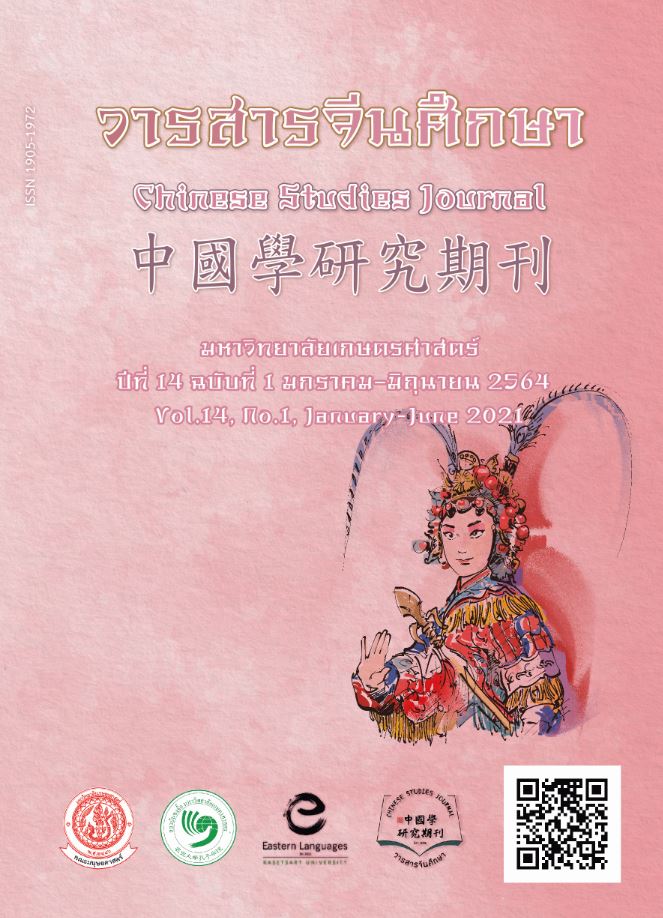Ideas, Love and Food: Conceptual Metaphor in Chinese
Main Article Content
Abstract
Chinese people is well-accustomed to the concept “food”, as they have both bodily and social experience about food. Chinese language users understand other target domains through the knowledge of source domain “food”. This study aims to explain the conceptual metaphors IDEAS ARE FOOD and LOVE IS FOOD in Chinese based on cognitive linguistics aspect. The data were collected from Corpus of Center for Chinese Linguistics (CCL). A result of study indicated that metaphorical expressions found in this study reflected the Chinese conceptual system “IDEAS ARE FOOD” and “LOVE IS FOOD”. The concepts of ideas and love are structured and understood in terms of food. These metaphors indicated that in which the language user tried to understand abstract object through the concrete object. The study shows the mapping between source domain “food” and target domain “ideas” and “love”, which makes us understand more about Chinese people’s world view.
Article Details
ผลงานทางวิชาการที่ลงตีพิมพ์ในวารสารจีนศึกษา มหาวิทยาลัยเกษตรศาสตร์ เป็นลิขสิทธิ์ของผู้เขียนหรือผู้แปลผลงานนั้น หากนำลงในวารสารจีนศึกษาเป็นครั้งแรก เจ้าของผลงานสามารถนำไปตีพิมพ์ซ้ำในวารสารหรือหนังสืออื่นได้โดยมิต้องแจ้งให้ทราบล่วงหน้า แต่หากผลงานที่ได้รับพิจารณานำลงในวารสารจีนศึกษา เป็นผลงานที่เคยตีพิมพ์ที่อื่นมาก่อนเจ้าของผลงานต้องจัดการเรื่องปัญหาลิขสิทธิ์กับแหล่งพิมพ์แรกเอง หากเกิดปัญหาทางกฎหมาย ถือว่าไม่อยู่ในความรับผิดชอบของวารสารจีนศึกษา มหาวิทยาลัยเกษตรศาสตร์ ทั้งนี้ ความคิดเห็นต่างๆ ในบทความเป็นความคิดเห็นส่วนตัวของผู้เขียน ไม่เกี่ยวกับกองบรรณาธิการวารสารจีนศึกษา มหาวิทยาลัยเกษตรศาสตร์
References
ภาษาไทย
ปาลิตา ผลประดับเพ็ชร์. (2560). “อุปลักษณ์แสดงอารมณ์ในภาษาไทย”, วิวิธวรรณสาร, 1(1): 63-86.
พราวพรรณ พลบุล. (2561). “อุปลักษณ์เชิงมโนทัศน์จากบทเพลง J-POP”, วารสารมนุษยศาสตร์และสังคมศาสตร์ มหาวิทยาลัยขอนแก่น, 35(2): 331-361.
ภาษาอังกฤษ
Cruse, D. Alan. (2000). Meaning in Language. Oxford: Oxford University Press.
Irina Popaditch. (2004). Metaphors of Love in English and Russian. Retrieved from http://www.scribd.com/ (30 มกราคม 2564)
Ungerer, F. and Schmid, H. (1996). An Introduction to Cognitive Linguistics. New York: Longman.
ภาษาจีน
张少姿.(2009). 汉语人体器官名词的隐喻研究. 《河北理工大学学报:社会科学版》, 4: 125-126.


